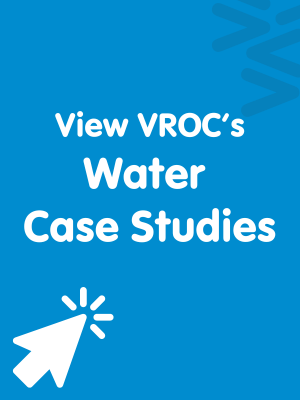Early stage technology adoption in the water industry is opening the way for advanced analytics and machine learning to provide operators with predictive insights. The industry has slowly moved from offline sensors and manual inspections, to the implementation of technology such as, GIS, SCADA, failure detection, smart pumps and connected vales and meters. The adoption of technology has been necessary with increasing pressure from ageing water distribution networks, increased water scarcity and climate change. Today the industry, including wastewater, water utilities and desalination plants, are under enormous pressure to maintain supply and availability whilst reducing costs and downtime.
The global Smart Water Survey, has reported that a large majority of water utilities have already started their digital transformation with the adoption of early-stage technology for real-time condition monitoring. The next step in the digital transformation of the Water Industry is Advanced Analytics, which is all about using data and advanced analytics (including artificial intelligence and machine learning) to identify and predict events earlier than ever before. With advanced analytics it is possible for the water utility operators to uncover valuable insights and benefit from; 
· Demand forecasting
· Predictive corrosion
· Predictive clogging
· Predictive leakage
· Predictive performance
Demand forecasting can be improved with auto-machine learning, which continually learns from historical and new data that is created from the distribution network. The machine-learning models uncover usage trends utilising additional data sources such as weather or population movements to give a more accurate forecast of what demand will be into the future. These forecasts can be used to better plan water networks in the future including sources, storage, treatment, and production from desalination plants.
Technology is advancing for the inspection of pipelines for corrosion, including low-frequency ultrasonic waves, fibre optics, ultrasound technologies, including magnetic flux technology using smart pigs. Water distribution owners and operators need to ensure corrosion is detected as early as possible to avoid leaks and supply issues. Advanced analytics can be applied to the pipeline data to detect minute changes in conditions, that otherwise would go un-detected. By predicting corrosion early, operators can adjust settings and plan interventions and predictive maintenance. It is also possible that critical lessons can be uncovered as to the causes of the corrosion which may bring about process improvement to the industry.
The accurate prediction of clogging can avoid water service disruptions and availability issues. Using data from the whole water network, auto-machine learning can identify changes in conditions which are early indicators of clogging. With this information, operators can plan interventions, so they are one step ahead rather than reactive. The use of Auto-ML can also show the contributing factors and root causes so that operators can make changes to systems to help avoid future issues. An example of this in action can be seen in this case study of a water filter clogging prediction.
Predicting leaks is critical and household smart meters will contribute greatly to this, by providing essential data. Auto-machine learning models are built to understand normal water flow and usage trends, and then they learn from new data to detect any possible leaks. Avoiding water wastage is critical, especially with water scarcity issues. Embracing this technology will transform the water industry, enhancing resiliency during climate change.
Advanced Analytics can also be used to predict the performance of critical equipment, processes, and systems. No-code ML models can be produced for predictive maintenance on pumps and valves, to predict output, as well as to optimize settings to reduce energy consumption or optimize chemical dosing in wastewater management, all whilst maintaining performance.
Four of these five areas fall under ‘predictive modelling’ which McKinsey have reported allows water utilities to see typical yearly savings of 10 to 20 percent in maintenance operating expenditures and 20 to 30 percent in capital expenditures. The opportunity which the Water Industry has before it, is to harness the increased volume of data, and apply advanced analytics. Ultimately this could result in fewer human inspections, lower maintenance costs and reduced downtime, which will help improve water services and minimise costs for consumers.
VROC's team have worked with water utility operators, experiencing great success applying advanced analytics to available data. Discover more about optimizing water utility operations with AI or get explore our case studies here.
Learn the differences between predictive, preventive, and reactive maintenance. Compare costs, benefits, and risks
Read ArticleHow to confidently move from pilot to enterprise-wide AI adoption
Read ArticleInterested in a demo of one of our data solution products?
DataHUB4.0 is our enterprise data historian solution, OPUS is our Auto AI platform and OASIS is our remote control solution for Smart Cities and Facilities.
Book your demo with our team today!
Complete the form below and we’ll connect you with the right VROC expert to discuss your project. Whether you’re launching a pilot, scaling AI across your enterprise, or integrating complex systems, we’ll help you turn your data into actionable insights—fast, efficiently, and with confidence.
The efficient deployment, continuous retraining of models with live data and monitoring of model accuracy falls under the categorisation called MLOps. As businesses have hundreds and even.
Learn more about DataHUB+, VROC's enterprise data historian and visualization platform. Complete the form to download the product sheet.
Learn how OASIS unifies your systems, streams real-time data, and gives you full control of your smart facility—remotely and efficiently. Complete the form to access the product sheet.
Discover how OPUS, VROC’s no-code Industrial AI platform, turns your operational data into actionable insights. Complete the form below to access the product sheet and learn how you can predict failures, optimise processes, and accelerate AI adoption across your facility.
Interested in reading the technical case studies? Complete the form and our team will be in touch with you.
Subscribe to our newsletter for quarterly VROC updates and industry news.